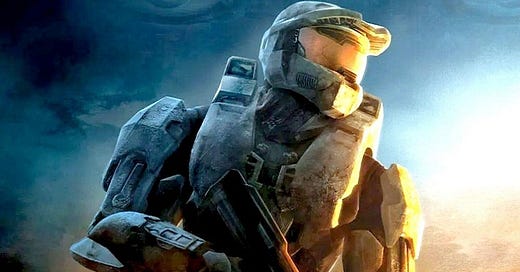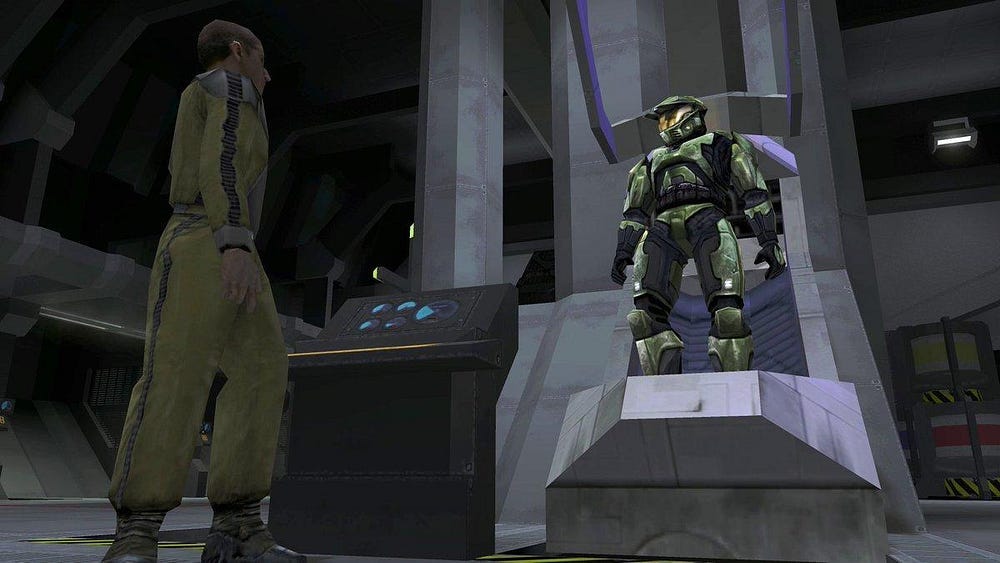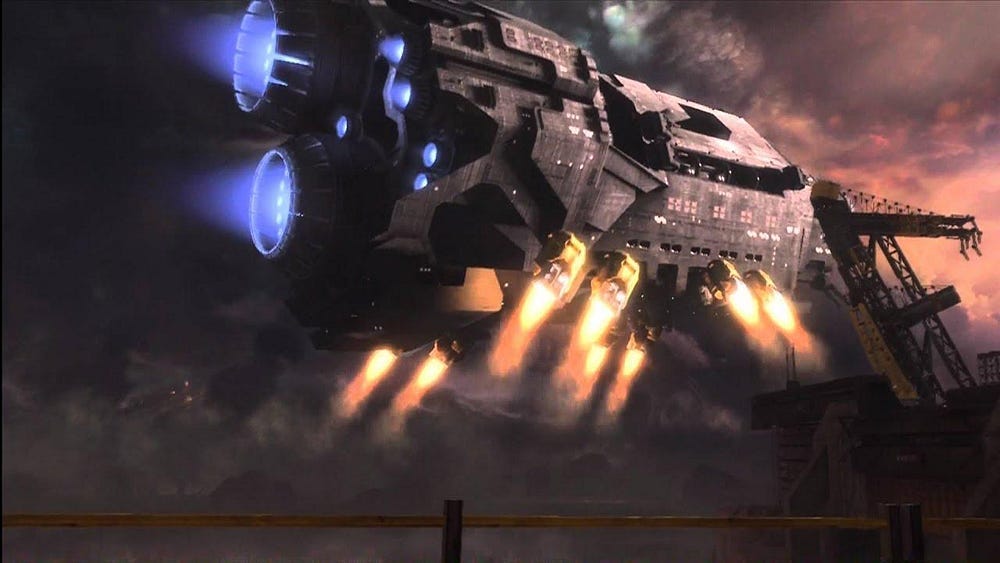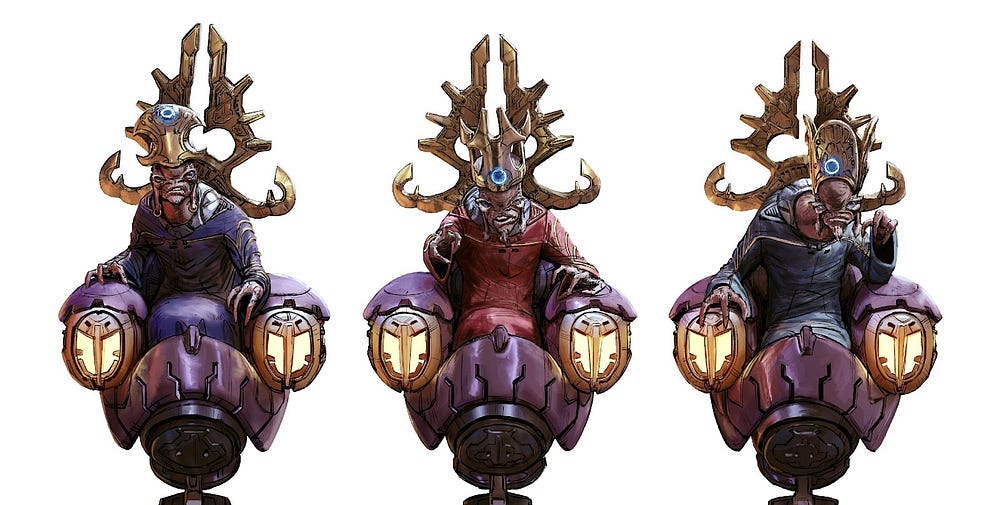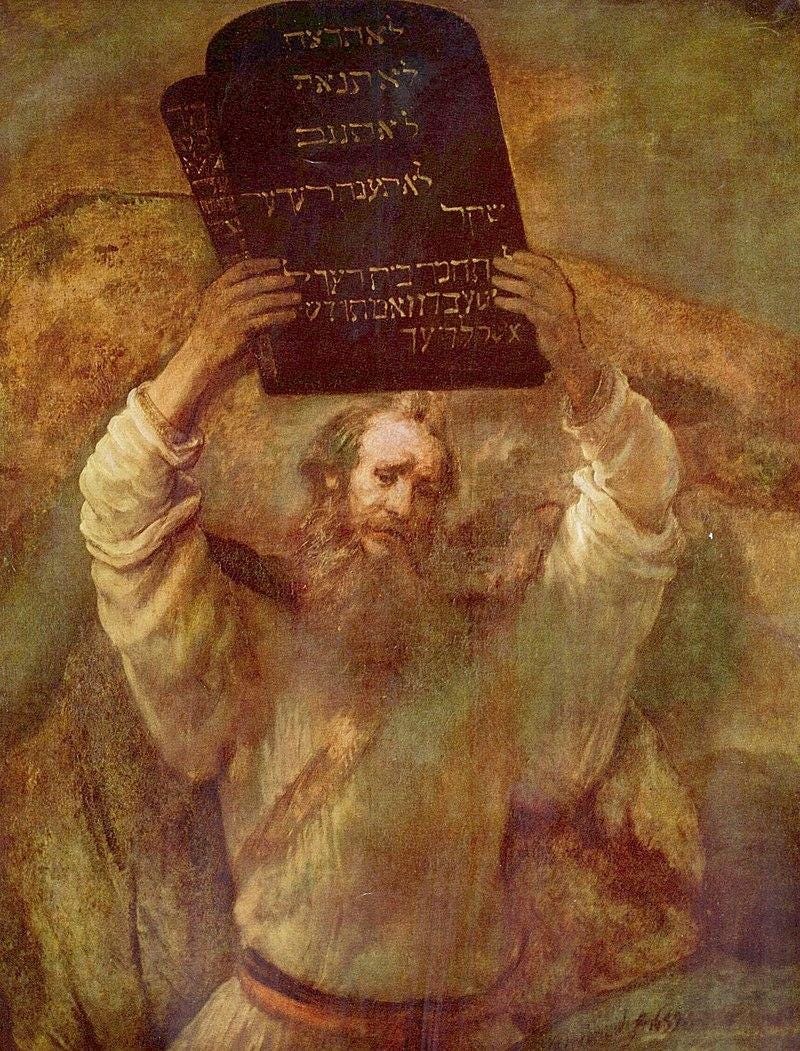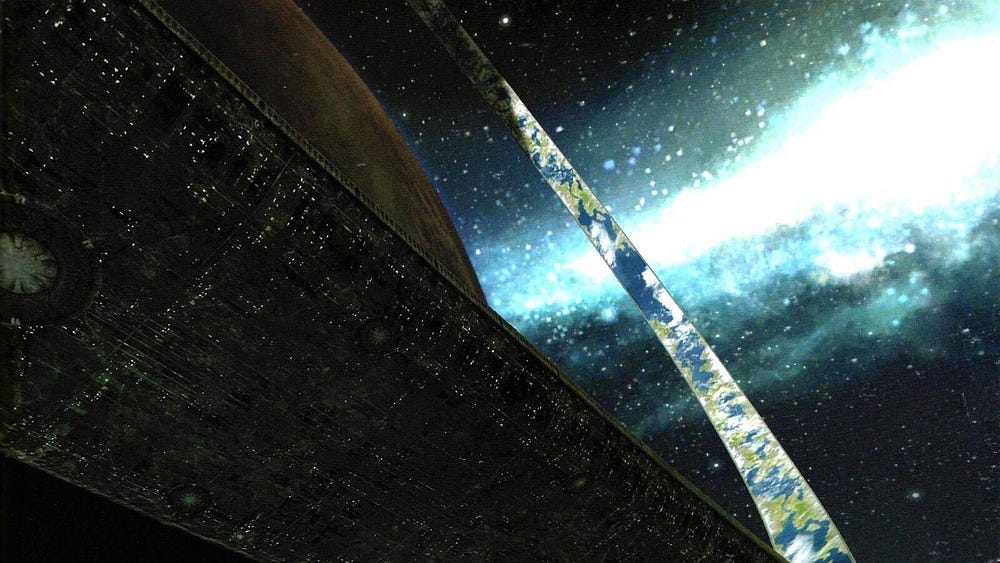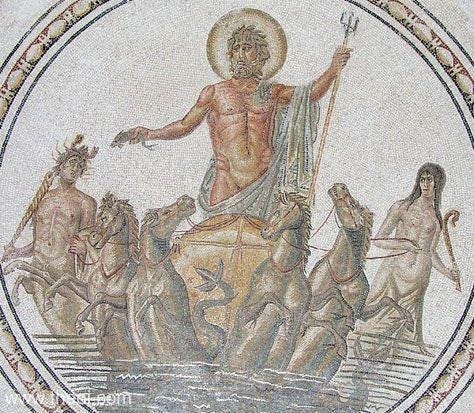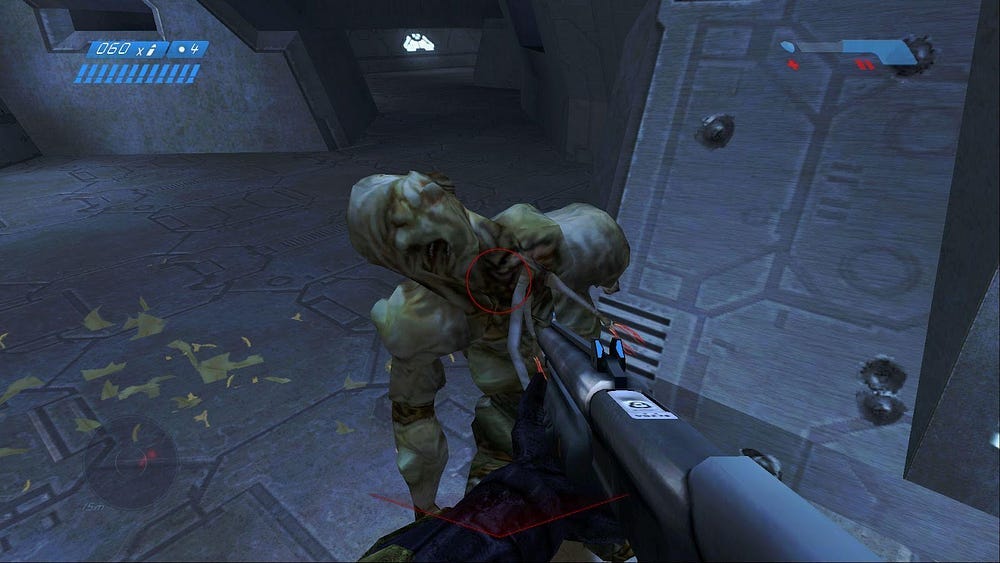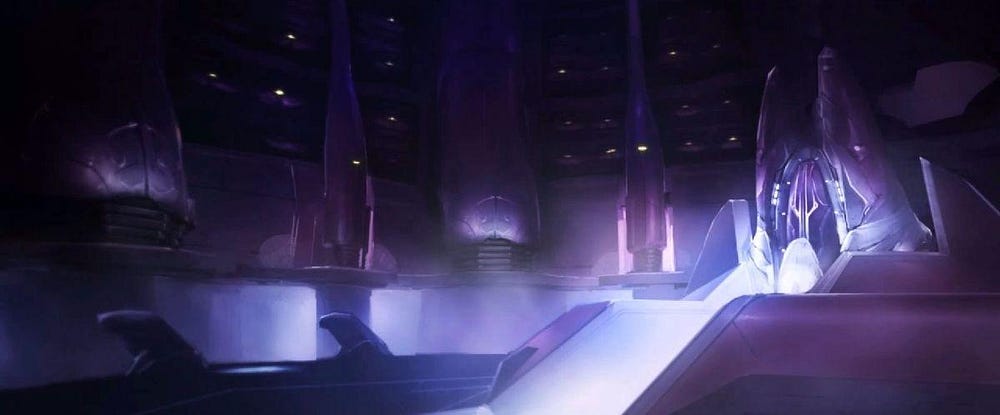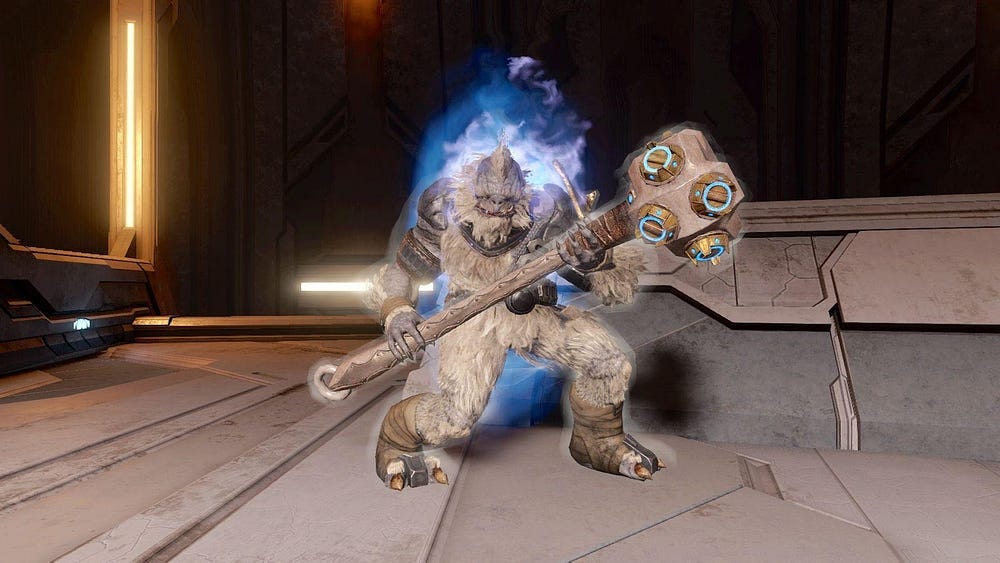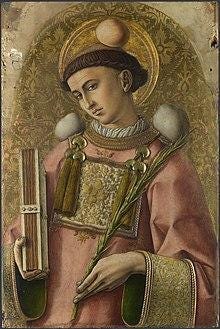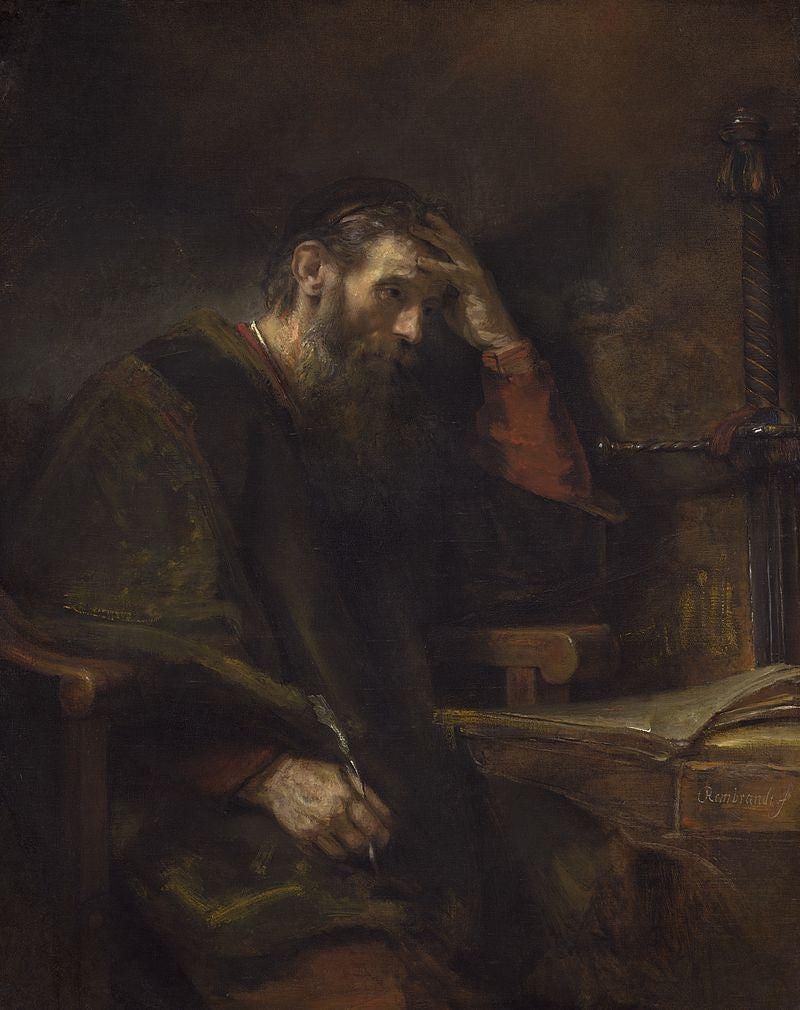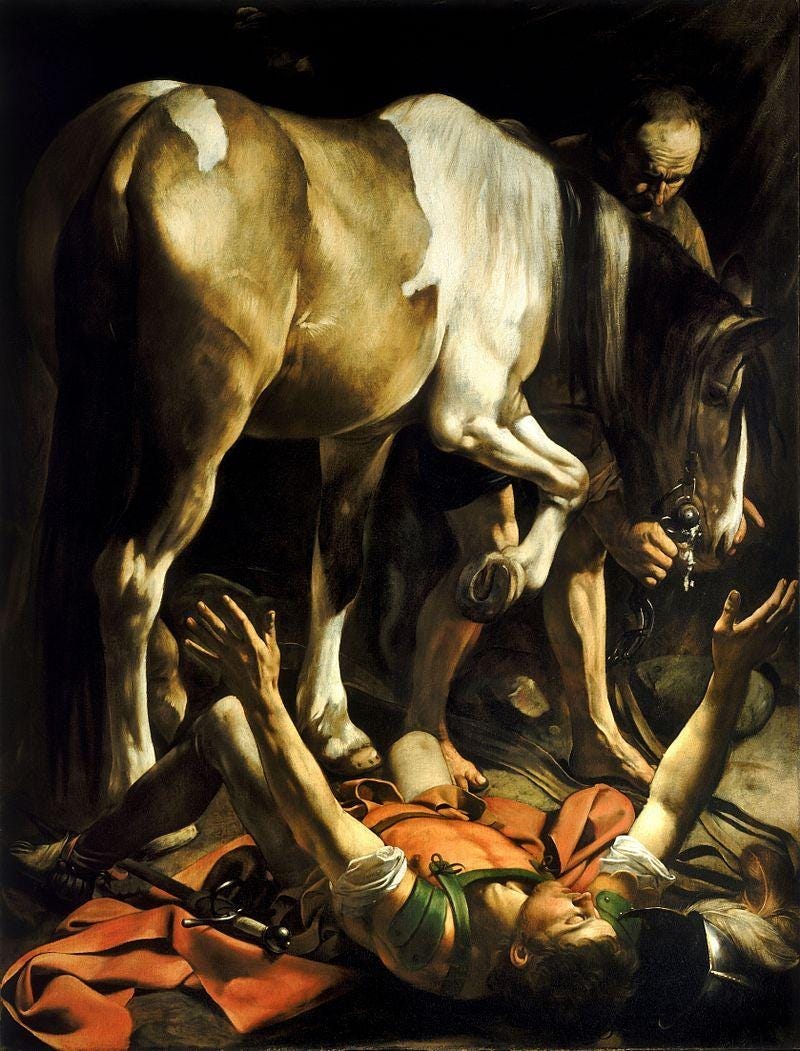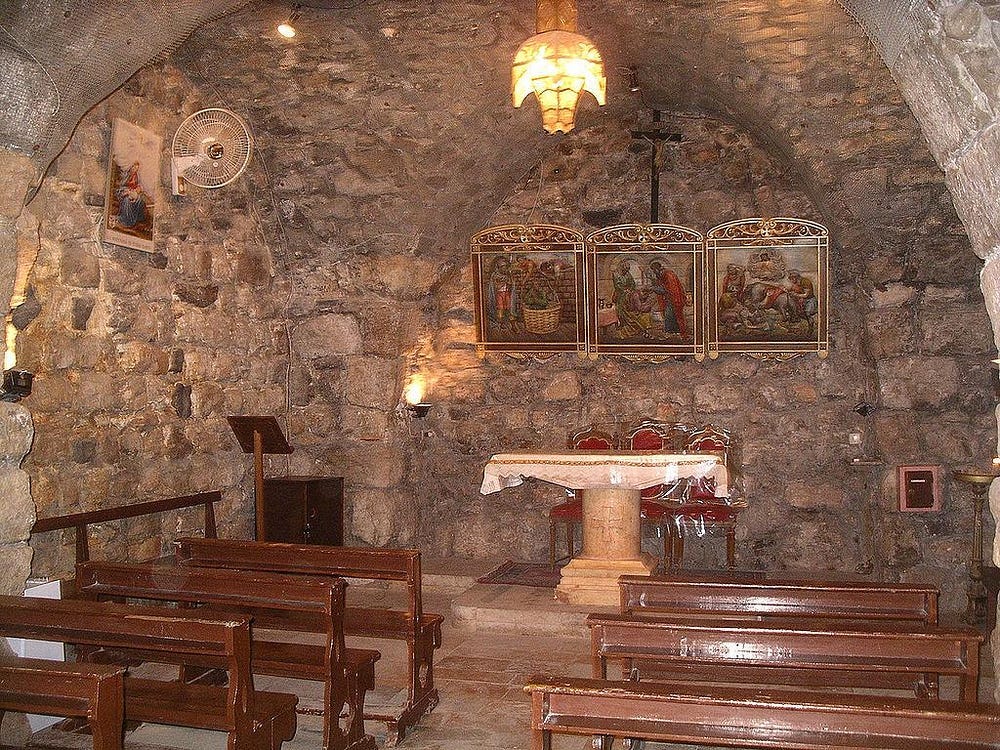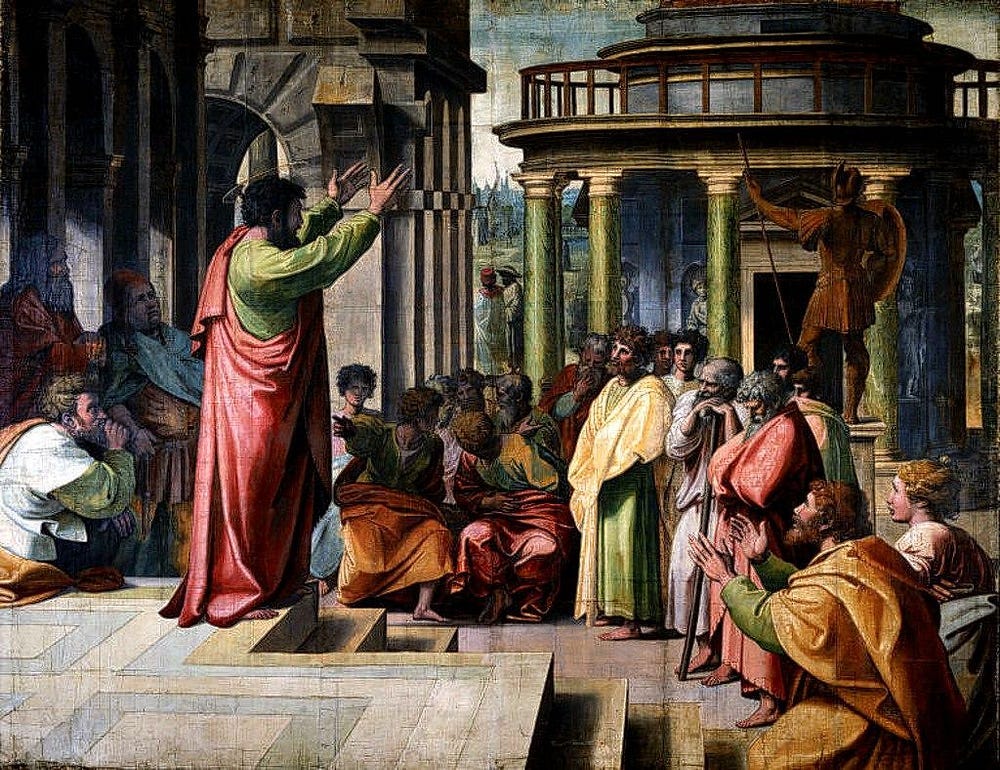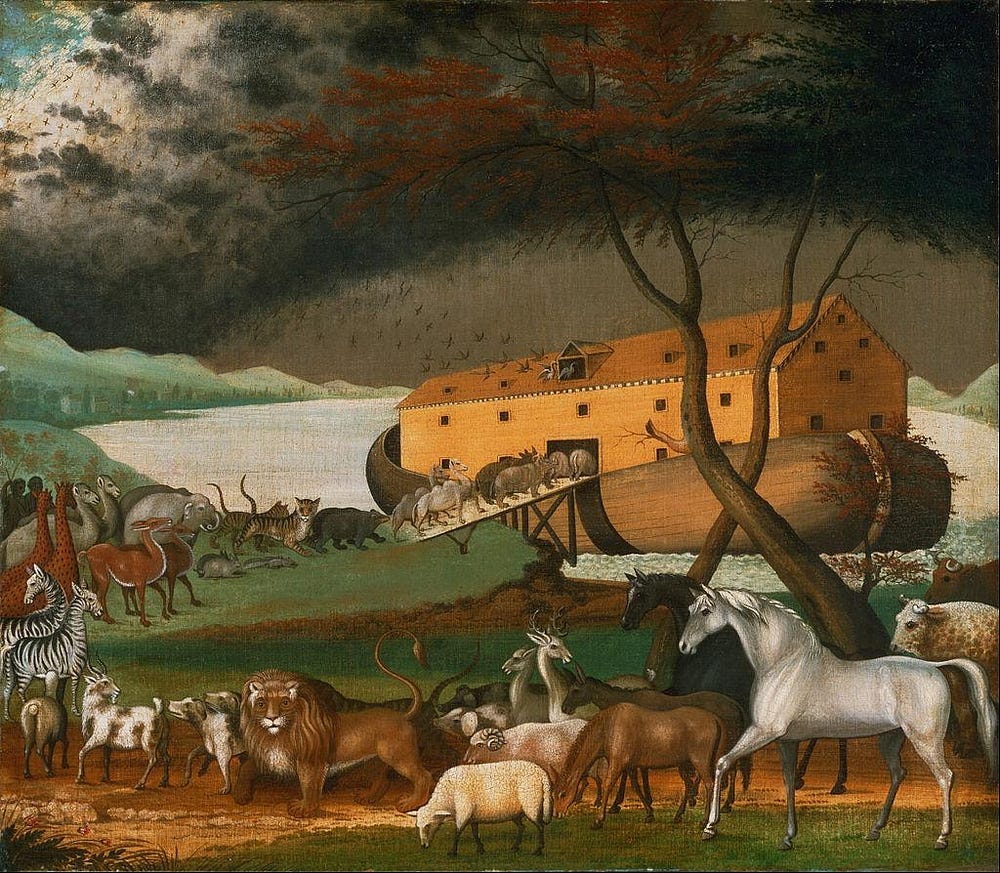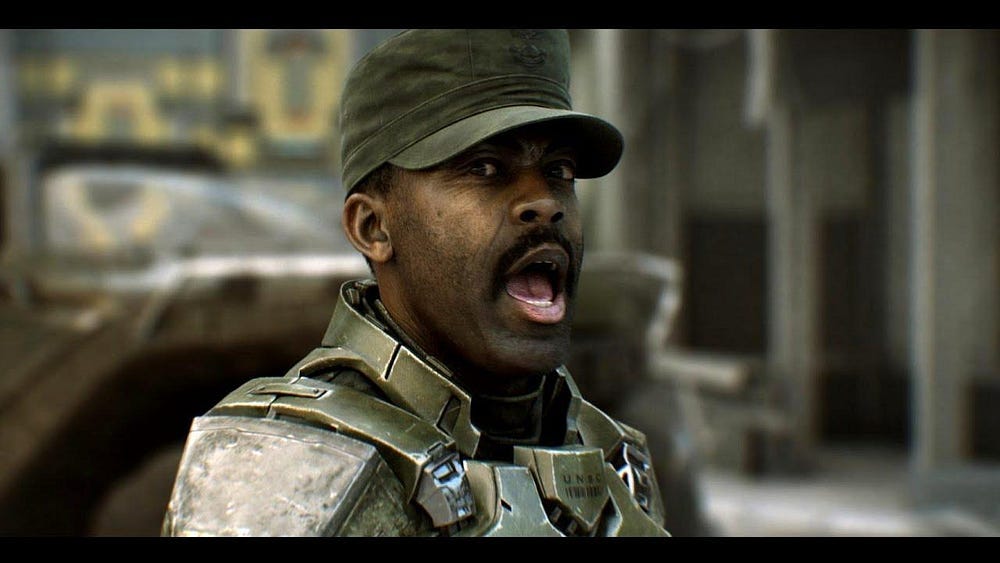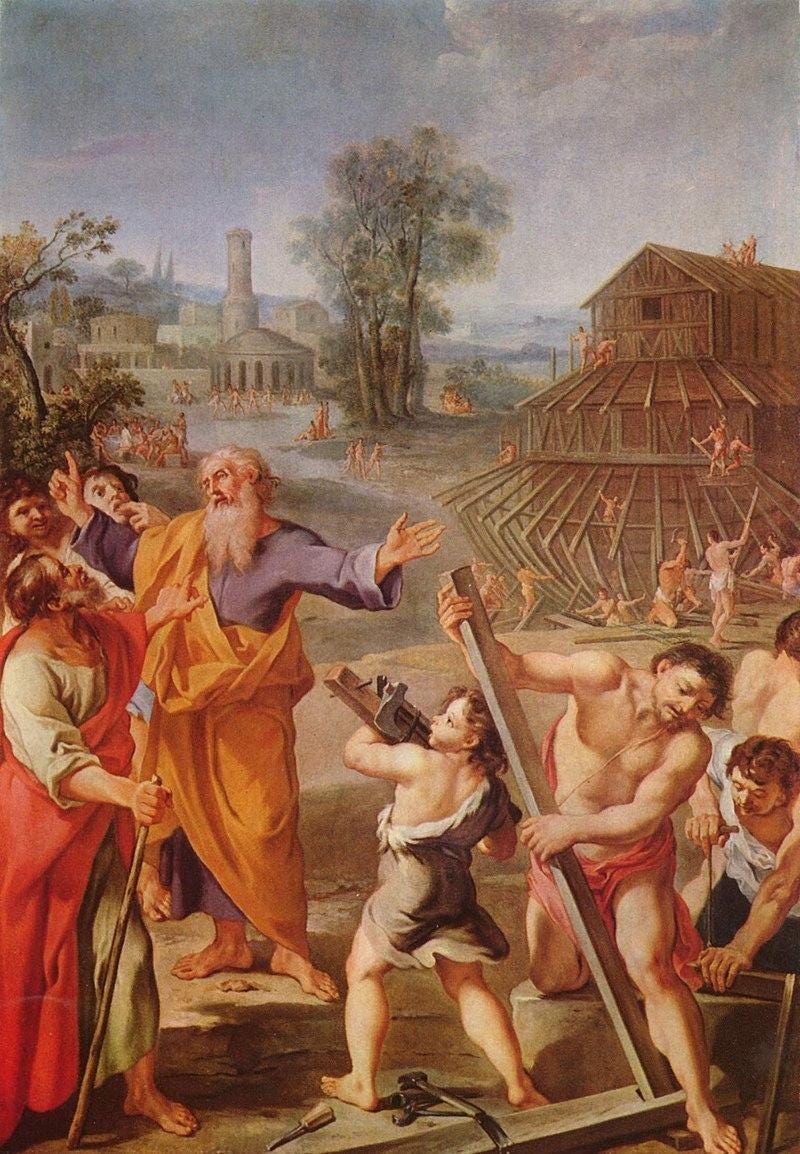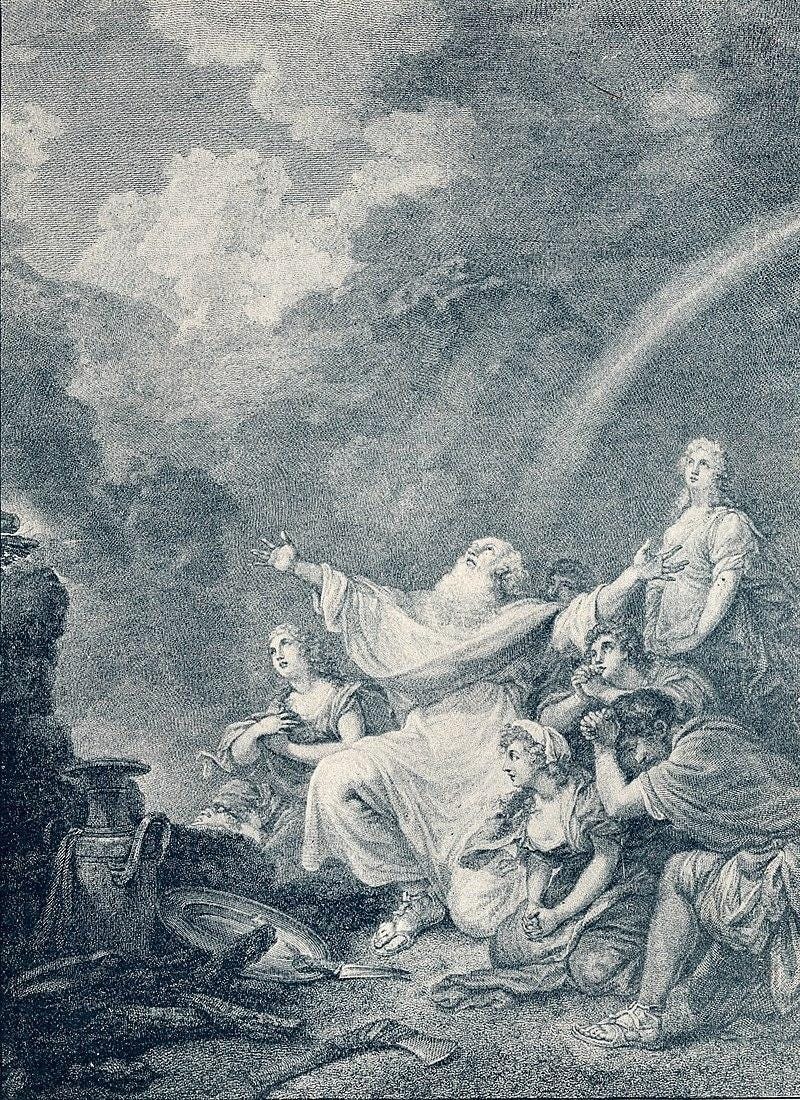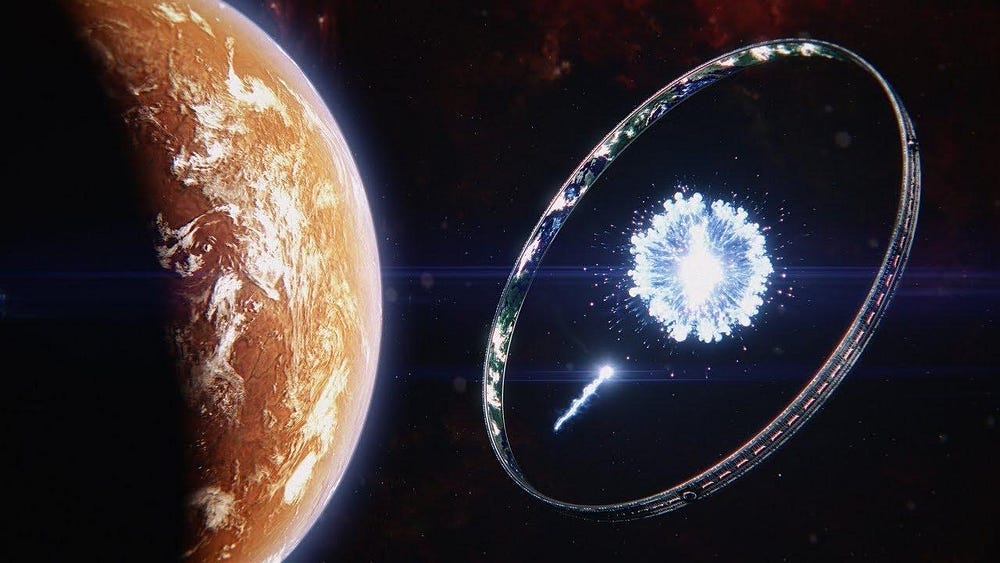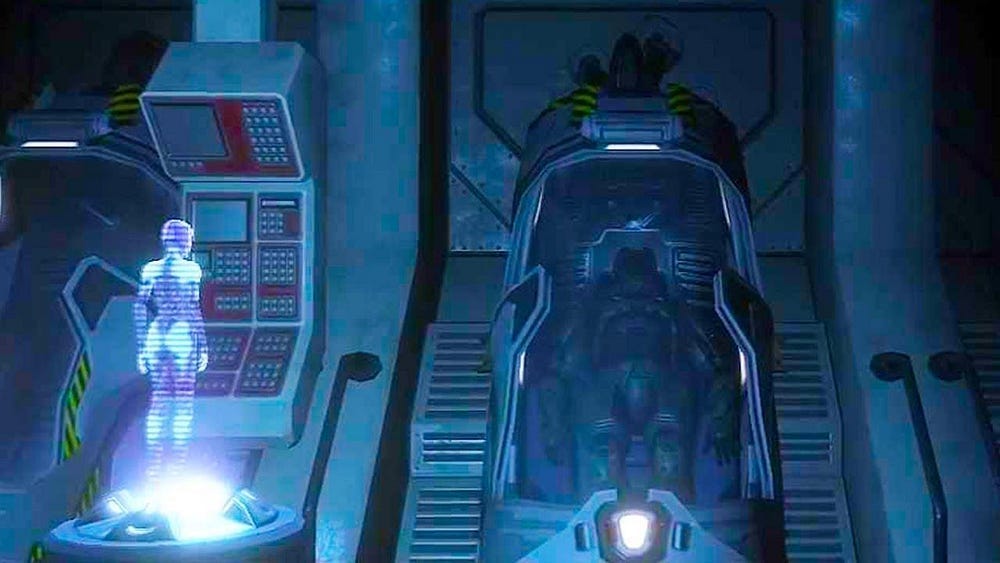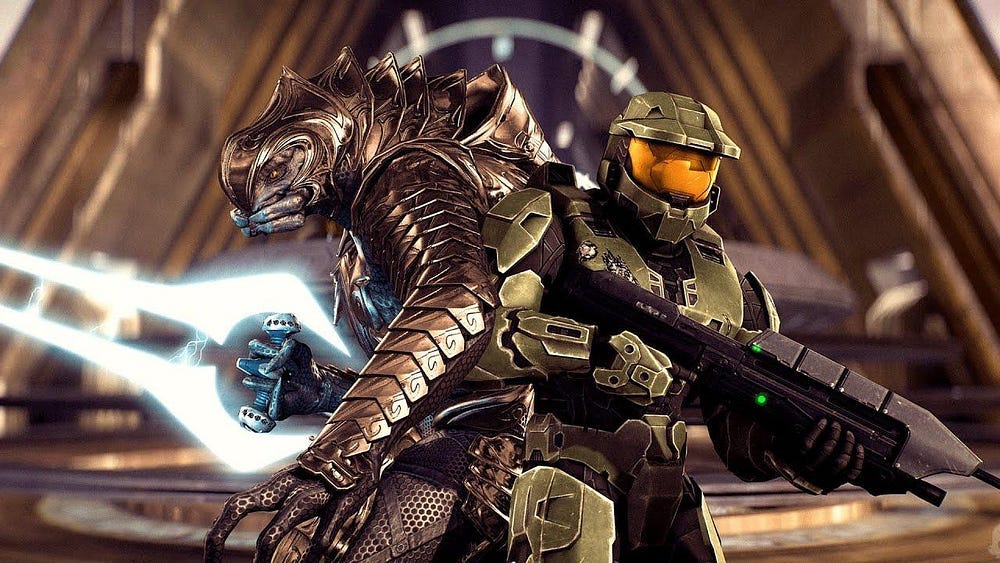Halo is one of the most iconic video game series of all-time. The Halo games redefined the first-person shooter genre, influencing all first-person shooters which followed. And the games guaranteed the success of Microsoft’s new Xbox platform. Even today, these early-2000s games are still widely-played and held to be among the greatest games ever made.
Throughout the original Halo trilogy, there is a heavy reliance on religious symbolism. In particular, the trilogy uses the Covenant, the Flood, and the Ark. But the games also feature the Prophets and the Law. The main character symbolizes Christ, and the secondary protagonist symbolizes Paul the Apostle. So for whatever it is worth — famously J.R.R. Tolkien did not like allegory, while C.S. Lewis did use allegory — the Halo trilogy is a masterful allegory.
Halo: Combat Evolved
Halo: Combat Evolved is the first entry in the series. The game opens with Master Chief, the main character, awaking from cryogenic sleep. His other name is John 117, which is a reference to the corresponding verse in the Gospel of John. Here is that verse: “For the law was given by Moses, but grace and truth came by Jesus Christ.”¹
The Master Chief is a super soldier, a Spartan, trained from childhood for war and equipped with a suit which can sustain gunfire. The Spartans are humanity’s last hope in the Human-Covenant War. And in Halo: Combat Evolved, the Master Chief is Earth’s last remaining Spartan. In a sense, he is asleep until his time comes — much as the Word, the Logos, the Second Person of the Trinity ‘rested’ until he was born as Christ. Even then, He often said that His time had not yet come. The Word was slain before the foundation of the world, but His hour had not yet arrived.
John 117 is awoken from his frozen state as the ship he is on, the Pillar of Autumn, is attacked by Covenant forces. The Covenant is an alliance of alien species, led by the High Prophets, who are on a mission to fulfill their religion’s promise. That being, an afterlife known as the Great Journey. The Prophets are not on-screen until Halo 2, but it is useful to understand them now to better grasp their symbolism and the overall symbolism present throughout the Halo trilogy.
Symbolically, the Prophets are actually more like the Pharisees than the Old Testament prophets. But they do prophesize about the end-times, and hold that the Forerunners — a mysterious ancient race — are divine. However in Halo, the Prophets do not focus on prophecy as they are law-givers who demand totalitarian order within the Covenant. Only that cleanliness, will ensure the arrival of the “world to come” as it is called in Judaism; the Great Journey, the afterlife.² In Halo, allegorically speaking, the Covenant manifests patterns similar to the Biblical Jewish people, particularly those people present at the time of Christ.
The Prophets in Halo are an intellectual elite, concerned with proper behavior under the law. Even in their appearance they are the weakest in body among the Covenant, but the most intelligent. Their spirit is made manifest through the body of the Covenant. Much as the Pharisees’ will was manifest throughout the authority of some of the Temple-goers. The Prophets are all intellect, with improper heart, akin to the Pharisees’ treatment of Christ and his apostles.
The game takes place in 2552, with humanity presented as secular. Humanity is essentially the Gentiles, those outside of the Jewish religion in Biblical times. Humanity has no real knowledge of the Covenant religion, although they are aware of it. For the most part humanity stands outside the narrative of the Covenant, and would not bother with the Covenant at all if it was not politically necessary.
So the humans are the Gentile authorities, the Roman authorities, who care little for the concerns of the Jewish people — unless Judaism will directly affect Roman governance. These allegorical character-patterns are not perfect overlaps. John 117 is a human; a Gentile, so not from the Jewish religion like Jesus is. But we can see how humanity is presented as being outside the Prophets, the law, and the Covenant. We will also see how John 117 is still the Christ figure in the Halo games.
Historically, the idea of a “covenant” began with legal custom and was later replicated in religion.³ That may be why the Pharisees have a more prosecutorial mind toward Christ. The Pharisee sect of Judaism had roots in a more legalistic tradition, which places great emphasis on covenant. And that is similar to how the culture of the Covenant in Halo is highly-concerned with the law, to ensure the “world to come,” as mandated by the Prophets. The Prophets will later see John 117 as the greatest threat to the Covenant, much as the Pharisees saw Christ in that way.
In the legal sense of the word, a covenant was an oath to uphold the promise made between two parties. The stronger party would ensure the weaker party received punishment, if the promise was broken. That idea of a covenant was used to explain Israel’s relationship with God. Because God offered both unconditional and conditional covenants. In the book of Deuteronomy, and subsequently in the twice-daily prayer the Shema, there is the idea that as long as the Jewish people are faithful to God there will be ample crops. But if the people are not oriented toward God, the land will not support them.⁴
The covenant must be upheld, for things to work properly. Symbolically, the Jewish people must unify heaven which is abstract reality, with earth which is the material world, to bear fruit. That is what the Prophets in Halo are always at pains to instantiate throughout their Covenant. If the Covenant is not followed because the law is disregarded; the criteria for bringing about the Great Journey is disregarded — one of the most important points being to follow the intellectual class of the Prophets themselves, similar to the Pharisees — then there will be no Great Journey.
The Jewish people wandering in the desert were united through covenant. That covenant resulted in texts which were eventually unified, simplified, and codified as the Ten Commandments. However, the Decalogue (Ten Commandments) are not from Moses, who brings them down from Mount Sinai to the people, rather the Ten Commandments are from God.
In Halo, while the Covenant is a community unified by religious covenant — their covenant is from the Prophets and not God. That is similar to Moses in a sense, but it is also the complete opposite because the Prophets in Halo are false prophets. Following the law to reach the Great Journey, amounts to following the Prophets’ own message and not the message of the Forerunners; the ancient and mysterious race who the Prophets and Covenant hold to be divine.
Now, Jesus is rejected as a false Messiah in all branches of Judaism. In terms of symbolism, it is the destiny of the Master Chief to be viewed as a heretic and blasphemer against the Covenant’s Great Journey, like Christ. In Deuteronomy 13:1–5 we have a definition of a false prophet:
“If a prophet, or one who foretells by dreams, appears among you and announces to you a miraculous sign or wonder, and if the sign or wonder of which he has spoken takes place, and he says, ‘Let us follow other gods’ (gods you have not known) ‘and let us worship them,’ you must not listen to the words of that prophet or dreamer. The Lord your God is testing you to find out whether you love him with all your heart and with all your soul.
“It is the Lord your God you must follow, and him you must revere. Keep his commands and obey him; serve him and hold fast to him. That prophet or dreamer must be put to death, because he preached rebellion against the Lord your God, who brought you out of Egypt and redeemed you from the land of slavery; he has tried to turn you from the way the Lord your God commanded you to follow. You must purge the evil from among you.”
We can see how there would be some kind of grey area, with Jewish people claiming Jesus worked miracles to introduce himself as another god; “gods you have not known.” Meanwhile the Christian interpretation would be that Christ was not a new god, nor a god one has not known, but is the incarnation of the very God of Israel who inspired that Deuteronomy passage.
The Master Chief is referred to as “Demon” by the Covenant. He is the inversion of their religion’s ideal, as he attempts to stop the Great Journey. They view him as a false prophet who introduces new religious ideas which run counter to the Covenant. Christ isn’t considered a demon in Judaism; nor is he considered to be the inversion of their religion. But he is considered a false prophet for claiming to be the Son of God. So in a sense both the Master Chief and Christ have aims outside or beyond the original covenant — in the thought of the holders of the original covenants. Most particularly, the thought of the Prophets of the Covenant, and the Pharisees.
Humanity has been fighting the Covenant throughout the known universe and has lost many human-colonized planets. Yet the Covenant does not know the location of Earth. While the Pillar of Autumn is attacked, the ship’s leader Captain Keyes, decides to abandon the ship so that the Covenant cannot use the information on the ship to locate Earth. Master Chief is onboard and fights his way to an escape pod, as do the rest of the soldiers who do not die while the Covenant boards the Pillar of Autumn.
The Pillar of Autumn is an old and small ship where “grace and truth” originate from; where John 117 originates from in the Halo story. Symbolically, we can look at his waking up on the ship as being akin to Christ being born in a manger — a cave in Bethlehem; an insignificant outpost on the fringes of the Roman Empire.
John 117 is sleeping in a pod. He is the greatest soldier who ever existed. He begins in a manger; in an insignificant ship on the fringes of the United Nations Space Command’s army, the Gentile army. Bishop Barron notes how the great joke of God is that the Master of the Universe should appear in such an insignificant time and place, even while persecuted by Herod the Great.⁵ John 117 also appears while he is persecuted by the Covenant.
All the surviving humans escape on the drop pods and crash land on the nearest object in space. It is a huge ring world, Halo, which humanity has never seen before. In terms of symbolism, halos often represent a glow of sanctity. Halos originate in Hellenistic Greece and in Rome — and we still have 2nd century frescos, although the halos potentially began before then with the Zoroastrian hvarena: “glory” or “divine lustre.”⁶⁷
Halos are often used in iconography to depict saintliness or to identify Christ. It is the Master Chief’s symbolic destiny, as a symbol of Christ, to be surrounded by a Halo.
It is no coincidence that the Halo theme song is Gregorian monks chanting, as religious symbolism permeates the game’s world. The following is a rumour, but people claim Halo’s original title was Covenant. However that title was thought to be too religious to be commercially successful. Even Halo: Combat Evolved adds a subtitle which tries to draw focus away from the religious name. Yet it is precisely the religious themes which gave Halo what made it so beloved: the presence of the ancient, the mysterious, and the expansive.
The Covenant consider Halo to be a holy relic — the key to beginning the Great Journey. Symbolically the New Testament uses light, which is what a halo is, to speak of God.
“In poetry, this symbol of light is chiefly used in the form of rays and flames or a diffused glow. The Bible presents the best example: God is Light. The Son of God, the Brightness of His Father’s glory (Hebrews 1:3). An emerald light surrounds God and His throne (Revelation 4:3), and the Son of Man seems to the prophet a flame of fire (Revelation 1:14 sq.). So also He appeared in His Transfiguration on Tabor.”⁸

For now we will focus on the Old Testament. Because the Covenant in Halo, due to the Prophets, is more concerned with the law: proper cleanliness and righteousness to bring about the “world to come.” In the Old Testament we see God appear in a cloud on Mount Sinai, which both hides and reveals Him; and we see Moses shine with a bright light in the presence of God.⁹ These imagistic representations led to halos being used in iconography throughout Christianity.¹⁰
Back on Halo, the Master Chief finds that the Covenant is already on the ring world. Throughout the game the player learns that Halo itself is a super weapon, which the Covenant aims to use. The Covenant believes that firing Halo is the fulfillment of the Prophets, and will bring about the Great Journey, the “world to come.”
The Covenant is zealous in their cause to fulfill the Prophets’ claims and cares little for the Gentile world of humanity. That isn’t a direct match to the Jewish people and the Gentiles. But allegorically, we can see how the Covenant is more concerned with their own religion and its law, rather than the beliefs of the pagan world around them.
The Prophets will stop at nothing to fire Halo. The word prophet, combines the two Greek words pro (in advance) and phesein (to tell). So a prophet is someone who predicts the future or acts as a speaker for the divine. Some prophets in the Jewish and Christian tradition include Abraham, Moses, Isaiah, Samuel, Job, and Daniel is only considered a prophet in Christianity.
In Christianity, a false prophet is someone who preaches a Gospel against the revelation of Jesus Christ, as was revealed to the apostles and explained in the Bible.¹¹ A true prophet is someone who more fully reveals God’s plan for humanity. The Prophets in Halo function as both prophets and theocrats. They prophesize about the Great Journey and how to uphold the law to fulfill the Great Journey. But they also rule over all the other alien species which are allied within the Covenant because of the Prophets supposed, special knowledge.
Again there is a difference here between the Covenant and the Jewish covenant. Because in Judaism the covenant is for those with Jewish ancestry — or those who opt into the Jewish beliefs, way of life, choice to follow the Law, and decisions to worship God and have a relationship with God. The Covenant in Halo is a dictatorship of the Prophets.
It is a theocracy, willing to enslave other species to demand that they follow the law. That is how the Covenant came to be in the first place, by the Covenant enslaving other alien species. So there are huge differences between the Covenant and Judaism, but in both there is still an emphasis on the prophets, the law, covenant, and all of that leading to the “world to come;” the Great Journey. Much of that is true of Christianity too. But Christianity places a greater emphasis on the spirit of the law because Christ exemplified spirit being greater than letter. A person, Christ, was the fulfilment of the written Law.
The game progresses and humanity attempts to control Halo, but the Flood is released in the process. The Flood is a parasite which can infect any living organism and turn them into a hybrid monster: half-Flood, and half-Human or half-Covenant. Symbolically, much like the Covenant, it’s not hard to tell what the Flood represents and participates in.
The Genesis flood narrative is the Hebrew telling of a story common to all Middle-Eastern and ancient civilizations.¹² The myth of a global flood destroying all life first appears in the Old Babylonian period, which is from the 20th century to the 16th century B.C.¹³ While scientifically it is doubtful there was a world-encompassing flood, it is scientifically possible there was a Black Sea Deluge or a Persian Gulf flood around 7,500 years ago.¹⁴¹⁵
Either possibility would have flooded the areas — the known world — of these Middle-Eastern and ancient civilizations. So as far as the writers of Genesis were concerned, there was literally a world-encompassing flood, with that being a scientific fact. Even though the idea of scientific fact being separate from spiritual fact was not thought of until the advent of science in the 1500s, further cemented by the Enlightenment in the 1600s and 1700s.¹⁶
The Biblical flood narrative is about God’s decision, because of human sin, to return the world to its pre-Creation state. That means, the dry land will be gone: the structure, predictability, order, “space.” And the world will be returned to water: rest, renewal, chaos, “time.”¹⁷ Yet God intends to re-create the world with Noah’s Ark serving as a microcosm for all of Creation.¹⁸
In that story, God says: “And, behold, I, even I, do bring a flood of waters upon the earth, to destroy all flesh, wherein is the breath of life, from under heaven; and every thing that is in the earth shall die.”¹⁹ The Flood in Halo will destroy all sentient life — anything with flesh and the breath of life. In the Biblical story, God is particularly concerned with how much violence there is from humanity. And the Flood in Halo arrives as humanity is in an intergalactic war. God finds Noah, one righteous man, and tells him to build an ark to survive the flood. We will later return to the Biblical flood narrative and the ark in the context of Halo’s symbolism.
The player learns, not only is Halo a weapon designed by the ancient Forerunners around 100,000 B.C. to destroy the Flood — but Halo destroys the Flood by killing the Flood’s food source. Halo will destroy all flesh with the breath of life to stop the Flood. So the Flood in Halo is only stopped by another flood. In a sense, the flood is inevitable. It’s just a matter of how one will deal with it. The subsequent games will explore that symbolism.
Still, the Covenant believes activating Halo will bring about the beginning of the Great Journey. They aim to fire Halo. It is a belief continually propagated by the Prophets, who demand all their followers follow them; not the Forerunners; not the divine. The Pharisees want to be followed; they cannot tolerate anyone following Christ; the Divine.
The Master Chief is able to stop the activation of Halo by detonating the Pillar of Autumn, which destroys Halo as he escapes into space on a different ship. He goes into “space” as he restricts “time”. Space is the dry land, order. And time is the water, chaos. The detonation eliminates the Flood and the Covenant forces surrounding Halo, while sparing the universe at large.
Halo 2
Halo 2 begins with a scene in a mausoleum and there is an Elite on trial — the highest ranking Covenant species aside from the Prophets. A mausoleum is a building, a monument, which honours the memory of those buried there. The Elite was responsible for controlling the ring-world in Halo: Combat Evolved and failed. He is stripped naked, put on a cross, and tortured with a burning spear.
Symbolically, it is clearly an allusion to the Crucifixion and specifically the Piercing of the Sacred Heart. But the Elite is not Christ in the story; John 117 is. The Elite is one of the apostles. Still, symbolically we can watch the Elite fall into the underworld, destroy his own death, and resurrect like Christ. In a sense that pattern is also like the apostle who the Elite represents; that being Saint Paul the Apostle who in prison entered a great darkness only to later re-emerge.
The Prophets are trying to determine if the Elite is a heretic. The character torturing the Elite is Tartarus. He is the leader of the Brutes, another Covenant race which challenges the role the Elites have in the Covenant and who want to set themselves up as second-in-command; next to the Prophets. Tartarus is a Greek name, Τάρταρος, Tártaros, referring to a place of suffering for the wicked, a prison for the Ancient Greek Titans, and the underworld itself.²⁰
The Elite finds himself in both of these places of suffering. He is being punished for his failure, unlike Christ who is punished for His success. And the Elite suffers at the hands of his own religious kin, not at the hands of the Gentiles. Similar to the apostle who the Elite represents, as even in Athens, Paul was a sought after speaker despite some Jewish leaders wanting to kill Paul. (Although it is worth mentioning that Christ was first found guilty by the Jewish court, His own religious kin, before being turned over to the Roman authorities.)
Ultimately the Prophets conclude the Elite is not a heretic and offer him the title of Arbiter. Arbiter a title given to a disgraced Elite so that he may regain his honour. The Arbiter is known as “The Will of the Prophets” and is sent on suicide missions of the highest importance to the Covenant. The Prophets primarily send the Arbiter to assassinate heretics within their own religion; within their covenant. The new Arbiter does exactly that. He is a zealot and assassinates heretics, much like the origin story of Saint Paul, who the Arbiter allegorically represents. More on Paul’s origin story to follow.
Meanwhile on Earth, the humans are honouring their heroes from the events of Halo: Combat Evolved. Then Earth is attacked by a Covenant fleet. The humans manage to stay alive and the main Covenant ship which is carrying the Prophet of Regret, jumps through a “slipspace” portal. The Master Chief is on a different ship and follows the Covenant ship through the portal.
Now in a different part of the universe, the Master Chief finds himself in orbit around a second Halo ring. The humans realize the danger of another Halo and begin searching for the Index, the activation key for the ring, so that they can stop the Halo from firing. Master Chief is able to kill the Prophet of Regret, but more Covenant forces arrive and attack the Master Chief, causing him to fall into a lake where he is dragged further underwater by tentacles.
While that is happening, the Covenant is in turmoil over the death of the Prophet of Regret. The two remaining Prophets promote the Brutes to the position originally held by the Elites. The Arbiter steals the Index from the humans who found it. But then the leader of the Brutes, Tartarus, takes the Index and sends the Arbiter into a deep pit. The Arbiter is presumed dead. Those events begin what is known as the Great Schism within the Covenant.
In the depths of Halo, the Arbiter and the Master Chief are both being held by giant tentacles. It is revealed to the player, that the tentacles belong to Gravemind. He’s essentially the hive-mind and leader of the Flood. He is a giant parasite with high intelligence. So he is the personification of the Biblical flood, which returns both the Jewish and Gentile worlds to a state of pre-Creation. But to use John Vervaeke’s phrase, Gravemind is also the embodiment of parasitic processing.²¹
In other words, there is a sense in which Gravemind is a demonic force. He will destroy the identity of all humanity and the Covenant, so that his own identity will flourish. But in doing so, the parasite will destroy the host it needs to live. That is what a demon is and what parasitic processing is. It’s a dark force, a dark pattern, a dark spirit which latches on to an individual’s identity and destroys the identity from the inside out. That way the dark spirit can have body. Addiction is a good example of parasitic processing. And Gravemind is literally a parasite.
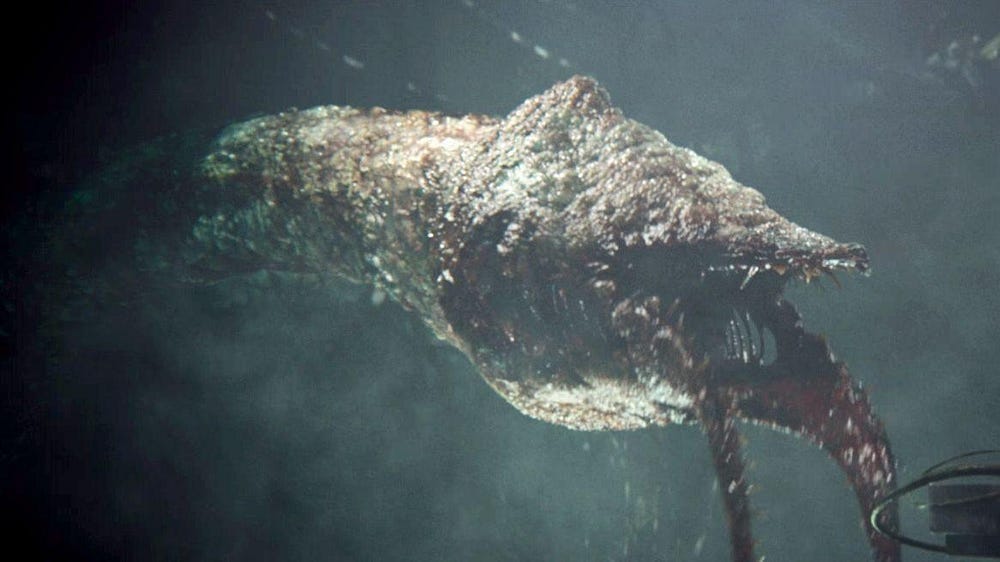
Gravemind tells the Arbiter that the Great Journey is a lie and sends the Arbiter and the Master Chief to different parts of Halo, to stop the ring’s activation. Gravemind is an advanced form of parasitic processing and understands that if the ring is activated he will die. There will be no food-source for the Flood. So the parasite identity will lose its host identity. It is at the point of The Arbiter meeting John 117 and Gravemind, that the Arbiter switches his allegiance from the Covenant — to the New Covenant of the Halo trilogy.
Allegorically, the Arbiter is Paul the Apostle. Paul was Saul of Tarsus — a town name similar to Tartarus — and Saul was a firm believer in Judaism. But that description barely scratches the surface. Saul held the covenant, the Law, and the prophets, in the highest regard — so much so that he actively persecuted followers of Jesus. He was even present at the stoning of Saint Stephen, the first Christian martyr.²² All of that is in alignment with the Arbiter’s character arc. Plus Paul was a Pharisee; he followed the legalistic covenant much as the Arbiter did.²³
But on the Road to Damascus, Saul had a vision where Christ appeared to him.²⁴²⁵ And Christ asked Saul, why Saul was persecuting Christ. Once Saul recovered from his literal blindness he was now Paul, perhaps the most devout preacher and evangelist of the Christian faith and known simply as “the Apostle.” Paul saw Christianity as the fulfillment of the Jewish religion. He had met Christ, as the Arbiter met John 117. Saul was thrown from his donkey upon meeting Christ and the Arbiter was thrown into a pit.
Further, it is only once John 117 plunges into the depths and meets the personification of the Flood: chaos itself, death, isolation, loss of meaning — that he appears to the Arbiter. Much as Paul is the Last Apostle because he meets Christ after Christ dies; after Christ has already been to Hades.
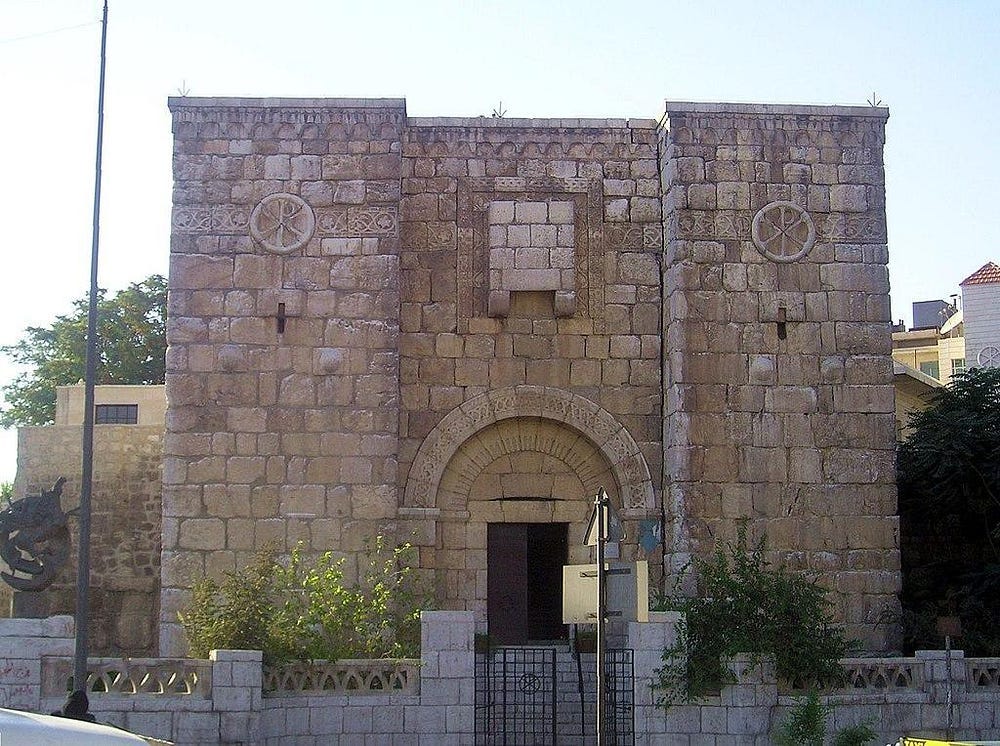
At The Last Supper, Christ instructs his now friends the apostles, to drink from His cup in remembrance of the New Covenant.²⁶ A New Covenant bought with Christ’s own blood on the cross.²⁷²⁸
The Arbiter, upon meeting John 117: “For the law was given by Moses, but grace and truth came by Jesus Christ,” is now on the side of humanity. The Arbiter sees the fulfillment of the Covenant’s promises of the “world to come.” Not so much in the law of the Prophets or within the Covenant itself, or even in a literal interpretation of the Great Journey, but in a New Covenant between formerly opposed nations. Humanity; the Gentiles, and the Covenant; the Jewish people, can now be together in a New Covenant. There will be a new heaven and a new earth through John 117.
However, as the Arbiter leaves Saul for Paul, and leaves the Pharisees for Christ, the Covenant is now in a full-scale civil war; the Great Schism. That name is clearly a reference to the Catholic-Orthodox Great Schism of 1054. The Brutes, led by Tartarus under the Prophets, are fighting against the New Covenant rebellion which is spearheaded by the Arbiter.
“The Will of the Prophets,” the Arbiter, transcends the letter of the law — the Covenant, instead choosing to embody the Spirit of the law — a New Covenant for all peoples. He is the Apostle to the Gentiles, to use the name given to Saint Paul. The Arbiter sees a new “heaven” in outer space and a new planet “Earth,” where humanity and the New Covenant are united through John 117. There is a new spiritual and material reality; unified.
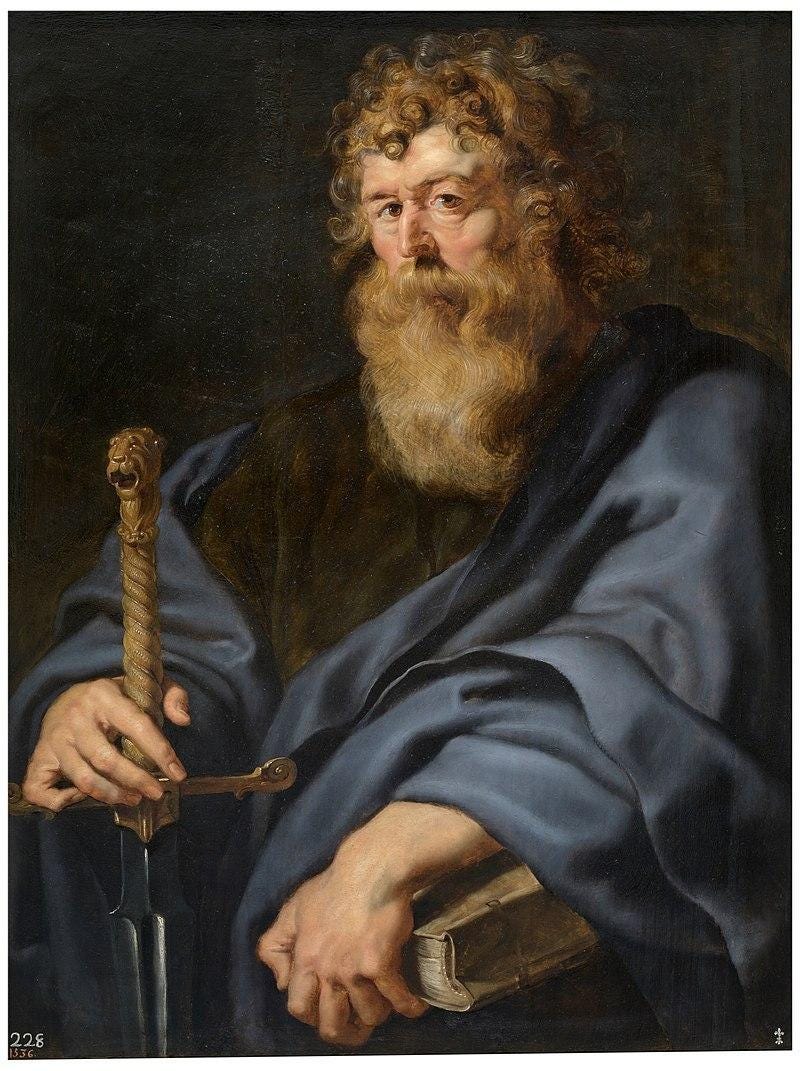
Rather than the old Covenant founded on race and birth, the New Covenant is one of spirit. There is no longer a physical circumcision but a “circumcision of the heart,” as Saint Paul said to Saint Peter in reference to the Gentiles who wanted to be Christians and eat at the same table as the formerly Jewish Christians.²⁹
The word arbiter essentially means mediator. Both words are legal terms and as we know, covenants were originally legal contracts before they were applied to religious thought.³⁰ So the arbiter meditates between the old Covenant and the New Covenant of John 117. Plus being a mediator, the Arbiter not only mediates between heaven and earth — abstract reality and material reality — and the heavens (outer space) and Earth itself, but he mediates between the Jewish people and the Gentiles. He mediates between the ‘New Covenant’ converts and humanity.
Eventually, a Flood infested ship which the Master Chief is on, crashes into Earth. In the chaos, the Prophet of Mercy is attacked by the Flood. The last remaining Prophet, the Prophet of Truth, does nothing to help Mercy; instead watching alongside the Brutes as the Prophet of Mercy is consumed by the Flood. Mercy is not shown mercy. The Pharisees fall into their own traps, as Judas threw the blood money on the Temple floor, leading to the purchase of the Blood Acre outside of the Temple because the Pharisees did not want to use that blood money either.³¹³²
The Arbiter and a human military force confront Tartarus in the Control Room of the second Halo. Tartarus is able to use the Index to begin Halo’s process of firing and killing all life in the universe. In doing so, beginning the Great Journey. The Arbiter tells Tartarus: “The Prophets have betrayed us.” But Tartarus does not believe in the New Covenant. So the Arbiter has to and does kill Tartarus, to remove the Index.
The Control Room now reveals that there are seven Halo rings, all of which have been put on stand-by because the Index was removed after the firing-process began. The Halo they are on will not fire, but the rings can now only be activated by something known as the Ark.
After these events, the Master Chief is shown on-board the Prophet of Truth’s ship, the last remaining Prophet. The ship is headed to Earth and in a cliff-hanger ending when John 117 is asked what he is doing on that ship, the Master Chief replies: “Sir, finishing this fight.”
Halo 3
Halo 3 begins with the Master Chief jumping from the ship he is on to Earth. He falls out of the heavens down to Earth. He comes into our world like Christ. The Covenant forces have been digging in Africa and unearthed the Artifact. It is a giant slipspace portal, which the Prophet of Truth enters in his own ship, and the humans then follow him through the portal.
Here, somewhere else in the universe, is the Ark. The Ark is a giant piece of Forerunner technology, which began building an eighth Halo ring after the original ring from Halo: Combat Evolved was destroyed. The Ark controls all the Halo rings.

So the Ark is the solution to the Flood, both in Halo and in the Biblical flood narrative. God uses the ark to spare Noah from the world-encompassing flood and save humanity. John 117 is allegorically Christ, the Second Person of the Trinity, who must use the Ark to stop the Flood and save humanity. Considering that God is a Trinity, Christ is present in Noah’s salvation through the ark. And John 117, allegorically Christ in the Halo series, must be present on the Ark. Additionally, Mary is held to be the Ark of the Covenant. More on that to follow.
The Arbiter’s forces deal with the new Flood threat on Earth. The Arbiter, like Paul, follows the example of Christ — John 117, in bringing salvation to Gentiles. Although the Prophet of Truth captures a human sergeant because a human is required to activate the Ark, as man is the microcosm of heaven and earth.³³ Man is the place where heaven and earth meet. Not least in the person of Noah.³⁴
So only a human figure could bring about the “world to come,” the Great Journey, the end of the Flood. Maybe that is why Christ had to be fully human. It was just a surprise that he was fully divine. The Covenant never saw John 117 as the solution to the Flood. Much as all strands of Judaism reject Jesus as the Messiah who would save humanity from the flood of humanity’s own sins. But Paul the Apostle, the zealot who assassinated heretics, did see Christ as God.
The Flood arrive on the Ark and the human sergeant is forced to activate the rings, as Gravemind forges a second alliance with the Arbiter and John 117 to stop the Prophet. The Arbiter assassinates the Prophet while the Arbiter symbolically has Christ in his heart — John 117 is right beside the Arbiter during the assassination — but the old Covenant is still against the Arbiter. Similar to how Paul had Christ in his heart: “It is no longer I who lives, but Christ who lives in me.”³⁵ (While some Jewish leaders of the first covenant wanted to kill Paul; like the High Prophets and Brutes with the Arbiter.)
With the Prophet dead, the activation of the rings is stopped. But Gravemind turns on the humans and the Arbiter. It is revealed that because the newest Halo is not fully complete, activating that ring will destroy both that Halo and the Ark itself. The Master Chief activates the new Halo, the eight Halo which the Ark is building. That will eliminate the Flood on the Ark, which is all of the Flood. And because the Ark is outside of the Milky Way Galaxy, humanity will be spared. Only the Flood will be destroyed. The ark saves humanity from the flood, both in the Biblical flood narrative and the Halo trilogy.
Noah’s Ark leads to a new covenant from God, where God says He will never again return the world to its pre-Creation chaos. It is the New Covenant of the Arbiter which leads to the Prophet’s death. As the Ark in Halo saves Gentile and Jew alike from the Flood. The universe does not return to a state of having no sentient life; a pre-Creation chaos.
For many years, it was thought Noah’s Ark could be found in the physical world. People maintained, using a literal interpretation of the story, that Noah’s Ark was on Mount Ararat and could still be found. Yet in Halo, as is the case with Noah’s Ark being a physical object in the material world — something to be physically found — the end of the Flood is the end of the Ark.
The Ark is no longer needed, once the chaos of the waters is resolved. The ark is symbolic, an imagistic representation which participates in and points to a greater reality. The Biblical flood narrative shows a pattern of reality. Whether or not Noah’s Ark can be found on the Earth is of secondary importance. Primarily, Noah’s Ark is not really of the Earth, but of heaven.
The ark is not of material reality, so much as it is an example. The ark story shows the utility of using the patterns of Being which exist above us, in the heavens — to survive chaos, by instantiating those patterns of spiritual reality down within material reality.³⁶ Noah takes the measurements of the ark from God; from above; and instantiates them in the physical world. Noah is a mediator between heaven and earth. That does not mean the story is a metaphor.
It means that the story participates in something way bigger than the scientific explanation of the story. The point of Noah’s Ark isn’t to go find Noah’s Ark. The point is to learn how to survive the flood. Whether or not a man named Noah survived the Black Sea Deluge in a boat with animals is almost beside the point. Because the story shows how to survive the flood, which is done through reference to God. The chaos of the earth is supplanted by the order of the heavens.
It’s not a metaphor because it is more real than a metaphor. It is as if there is a spectrum with literal on one end, metaphor on the other end, and symbolic in the middle. A symbolic story is one which both leans into a literal interpretation, but also leans into metaphor. It is as if that spectrum is a mountain range, with symbolism being the mountain peak itself, in the middle.
The story is more real than a literal story and more real than a metaphorical story. It is both and neither. It is a story which takes real events, but prioritizes the patterns of behaviour in the events — more than the forensic details of the events. It is a non-fiction account, which is more concerned with the meaning of the story than the camera-observer telling of the story — yet the story is not fiction. It could be a scientifically true story, but that isn’t the interesting part.
Because a person does not see the material world, so much as a person sees behaviours which can alter the material world. To really see — to act in the world based on abstract valuations about the world — is not about seeing material reality itself, so much as it’s about seeing potential. The material world is a place of decisions between chaos and order; “time” and “space,” in the ancient cosmology. We see the patterns which either underlie, or are above, the material world.³⁷
We can fall into the lower patterns; demonic parasitic processing, or be lifted up into the patterns of the heavens.³⁸ In either case we take the behavioural patterns of Being, which either underlie or are above, and instantiate those patterns into the material world. That can be heaven on earth, or hell on earth — man chooses as he is the meditator in-between, like Noah.
Now there is also the Biblical notion of the Ark of the Covenant. In the Old Testament, the Ark of the Covenant is a box with gold trim and the lid is called the mercy seat. The mercy seat has two cherubim on it and God appeared between the cherubim to speak with Moses.³⁹ The two stone tablets of the Ten Commandments, the rod of Aaron, and a pot of manna were inside.⁴⁰
The Ark of the Covenant was built one year after the Israelite Exodus, as the Ark in Halo 3 appears and starts building in 2253; one year after the events of Halo: Combat Evolved; and one year after the Covenant slaves headed toward Earth. The Ark of the Covenant was always carried before the Israelites during marches by the Levites (the priestly tribe); including toward war. Which is akin to how the Ark in Halo was in space ahead of the last Prophet, who was the religious monarch of the old Covenant.⁴¹
Revelation says that “the ark of his covenant was seen within his temple.”⁴² Theologians, including the Early Church Fathers and Saint Thomas Aquinas, see the contents of the ark as being made human in the person of Christ. The tablets of the Law become the One who gave the Law, Aaron’s rod becomes Jesus eternal authority as priest, and the manna becomes the Eucharist.
The next verse of Revelation is: “A great portent appeared in heaven: a woman clothed with the sun, with the moon under her feet, and on her head a crown of twelve stars.”⁴³ The number twelve is used often in the Bible. For example, the twelve Tribes of Israel and the Twelve Apostles. That most recent Revelation verse, Revelation 12, is thought to refer to Mary, with Mary being the Ark of the New Covenant.⁴⁴⁴⁵
Such an interpretation was held by Saint Gregory of Neocaesarea in the third century and by Saint Ambrose, Saint Ephraim, and Saint Augustine in the fourth century.⁴⁶ The Catechism of the Catholic Church says: “Mary, in whom the Lord himself has just made his dwelling, is the daughter of Zion in person, the Ark of the Covenant, the place where the glory of the Lord dwells. She is ‘the dwelling of God . . . with men.”⁴⁷
In Halo, the Ark begins as the Ark of the Covenant and becomes the Ark of the New Covenant, through the Christ figure John 117. Because of the Master Chief’s involvement, being inside the Ark — the last Prophet is stopped, which is a symbolic end to the Covenant itself. Through that the old Covenant falls, as the veil on the Holy of Holies in the temple was torn from the top down during the Resurrection; signifying the end of the old Covenant and the beginning of the New Covenant.⁴⁸⁴⁹
The Old Testament Ark of the Covenant was kept in the Holy of Holies, which was the veiled part of the Temple. But by having the Savior in her womb, Mary herself became the Holy of Holies. Still, the beginning of the New Covenant was because of Christ. So in Halo, John 117 is in the Ark — the savior of mankind bringing about the New Covenant: “For the law was given by Moses, but grace and truth came by Jesus Christ.”⁵⁰ John 117 is the fulfillment of the covenant.
The Covenant is defeated and the Arbiter’s New Covenant is all that remains, mostly because of John 117 and the Arbiter cooperating with John 117. The eighth ring fires as the Arbiter and the Master Chief escape on a ship. They enter the slipspace portal which leads to the Artifact, meaning they are heading back to Africa, while the portal itself collapses from the detonation of the ring. Only half of the ship makes it back to Earth. The side which makes it back to Earth, is the side the Arbiter was on. The Savior John 117 and the Ark of the New Covenant, both leave this life.
The Arbiter, embodying the role of Paul, is the last person to see John 117. Paul is the Last Apostle because Christ appeared to Paul in the vision on the Road to Damascus after Christ’s Ascension. There is a memorial service for those lost in the battle, including the Master Chief, who like Christ remains both in the heavens and in heaven.
John 117 loses his own blood forging the New Covenant. But the Flood is defeated, establishing that through the New Covenant, the Flood will not return.
The Arbiter leads his forces back home, having made peace with the humans through the New Covenant. The Gentiles and the Jewish “converts” to Christianity are on good terms because of the Arbiter playing the symbolic role of Paul the Apostle. He is the Apostle to the Gentiles.
The war is over. There is a new heaven and a new earth.
The player thinks the game is over. But then the other half of the ship is shown floating in space, with John 117 inside. He is in the heavens. He is alive. He is risen.
That is a symbolic resurrection. After, John 117 enters cryogenic sleep while saying: “Wake me, when you need me.” Deepening the symbolism of the Ascension and pointing to a Second Coming.
In Halo, Spartans like John 117 cannot be listed as KIA: killed in action. They can only be listed as MIA: missing in action. Because the human military holds that Spartans cannot die. Clearly John 117 is the Christ figure in Halo, as he rises again from his tomb. But that ending is also symbolic: John 117 is taking his place in the heavens, to return to earth when needed.
John 117 and the Arbiter bring about the New Covenant of the Halo trilogy.
Dan Sherven is the author of three books, including the number one bestseller Classified: Off the Beat ‘N Path. Sherven is also an award-winning journalist, writing for several publications. Find Sherven’s work.
Sources:
1. John 1:17
2. Spitzer, Jeffrey. “The Noahide Laws,” My Jewish Learning. 2018.
3. Mendenhall, George E. “Covenant Forms in Israelite Tradition,” in The Biblical Archaeologist. The American Schools of Oriental Research. 1954. 17 (3): 49–76.
5. Word on Fire. “Catholicism: Amazed and Afraid: The Revelation of God Become Man,” Word on Fire Catholic Ministries, 2010.
6. See “The Chariot of Poseidon,” Bardo National Museum, Tunis. 2nd Century AD.
7. Ramsden, E. H. “The Halo: A Further Enquiry into Its Origin,” The Burlington Magazine for Connoisseurs. 1941. 78 (457): 123–131.
8. New Advent. “Nimbus,” in Catholic Encyclopedia, New Advent. 2023.
9. Exodus 34:29
11. See Nei, Briana. Revealed in Ephesians: The Mystery of Who I Am in Christ. WestBow Press, 2019.
12. Leeming, David A. Creation Myths of the World: An Encyclopedia. Vol. 1. ABC-CLIO, 2010. 400
14. Ryan, W. B. F.; Pitman, W. C.; Major, C. O.; Shimkus, K.; Moskalenko, V.; Jones, G. A.; Dimitrov, P.; Gorür, N.; Sakinç, M. “An abrupt drowning of the Black Sea shelf,” Marine Geology. 1997. 138 (1–2): 119–126.
15. Ryan, W. B.; Major, C. O.; Lericolais, G.; Goldstein, S. L. “Catastrophic flooding of the Black Sea,” Annual Review of Earth and Planetary Sciences. 2003. 31 (1): 525−554.
16. See Pageau, Jonathan. These ideas are present throughout the body of work.
17. See Pageau, Matthieu. The Language of Creation: Cosmic Symbolism in Genesis: A Commentary, 2018.
19. Genesis 6:17
20. The Editors of the Encyclopedia Britannica. “Tartarus,” Encyclopedia Britannica. December 2022.
21. See Vervaeke, John. These ideas are present throughout the body of work.
22. Acts 8:1
23. Acts 26:5
24. Acts 26:13–14
25. Acts 22:7–9
26. See Sheen, Fulton. “Chapter 36: The Last Supper,” Life of Christ. Image Books, 1990.
27. Matthew 26:28
28. See Sheen, Fulton. “Chapter 36: The Last Supper,” Life of Christ.
30. Mendenhall, George E. “Covenant Forms in Israelite Tradition,”
31. Matthew 27: 6–8
32. See Sheen, Fulton. “Chapter 46: At the Bottom of the List,” Life of Christ.
33. See Pageau, Matthieu. The Language of Creation: Cosmic Symbolism in Genesis: A Commentary.
34. Bandstra, Barry L. Reading the Old Testament: An introduction to the Hebrew Bible. 61.
35. Galatians 2:20
36. See Pageau, Matthieu. The Language of Creation: Cosmic Symbolism in Genesis: A Commentary.
37. See Pageau, Jonathan. “Love and Attention — Thunder Bay Conference,” YouTube, October 22.
38. See Vervaeke, John. These ideas are present throughout the body of work.
39. Exodus 25:22
40. Hebrews 9:4
41. Joshua 3:4
42. Revelation 11:19
43. Revelation 12:1
44. Ray, Steve. “Mary, the Ark of the New Covenant,” Catholic Answers. October 2005.
46. Gustafson, David and Longenecker, Dwight. Mary: A Catholic Evangelical Debate. Gracewing, 2003. 32.
47. Catholic Church. Catechism of the Catholic Church. Libreria Editrice Vaticana, 2019. Paragraph 2676.
48. Matthew 27:51
49. See Sheen, Fulton. “Chapter 51: The Rending of the Veil of the Temple, Life of Christ.
50. John 1:17

